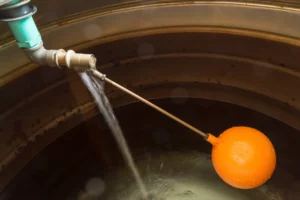
If you thought toilets were a simple place to do your business, think again. The humble commode is a complex piece of engineering. A major player in this ensemble is the toilet float. The toilet float is a small, buoyant device that floats (no surprise there!) in the tank of your toilet. When you flush, it descends with the water level and activates a valve which refills the tank. Once the tank is full, the rising float shuts off the valve. Sometimes, the float needs adjusting. Wondering how to adjust a toilet float? There are steps to follow and depends if it is a ball float or a cylinder float.
The Undercover Agent – an Alias for Toilet Float
Toilet floats can go undercover by several aliases. Sometimes referred to as “ballcock,” or “fill valve,” these names might sound funny, but each part plays an important role in the grand symphony that is your toilet’s operation.
Why You May Need to Adjust Toilet Float
So why would you need to meddle with this seemingly efficient system? Well, if the float is set too high, you’ll have constant running water as it overflow into the overflow tube. Set it too low and each flush will lack the strength required to cleanse the bowl efficiently. Thus, adjusting the toilet float to the proper level ensures optimal flush and prevents wastage of water.
Materials Needed to Adjust Toilet Float
Ready to adjust your very own toilet float? Here’s what you’ll need:
- Adjustable wrench
- Screwdriver
- Some patience
Steps to Adjust a Toilet Float
Adjusting a toilet float isn’t rocket science, thankfully. It’s quite straightforward once you know the ropes. Here’s how:
Step 1: Remove the top of the toilet tank.
Step 2: Locate the toilet float. It should be pretty easy to spot – it’s usually a ball on an arm or a cylindrical float that slides up and down on a rod.
Step 3: If it’s a ball float, twist the screw at the end of the arm to adjust it. If it’s a cylinder float, pinch the clip and slide it up or down.
Step 4: Replace the tank lid and give your toilet a test flush.
Other Recommended Maintenance
Now that you know about the toilet float, let’s take a look at a few other areas of recommended maintenance. One of those is the toilet bubbles while running the shower. This can be due to a clogged sewer drain, blocked vent, or incorrect plumbing.
Another is fixing a running toilet that doesn’t have a ball float. You will need to replace the fill valve and it will depend on the type of fill valve style you have.
When to Call a Professional
DIY is great, but there are times when it doesn’t quite cut it. If you’re experiencing consistent issues with your toilet, despite adjusting the toilet float, it may be time to call a professional plumber. They’ll be able to identify and solve any more complex issues that might be causing trouble.
Conclusion
With the knowledge of what a toilet float is, its alias, the materials necessary for adjustment, and when to call a professional, you’re now equipped to handle most basic toilet problems. While fun, remember that not everything can be DIY – don’t hesitate to call in the professionals when necessary. While tending to your toilet, you can call the Bentley Home Inspection team for a home inspection in East Tennessee and surrounding areas.





